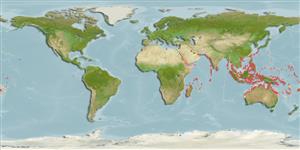Teleostei (teleosts) >
Blenniiformes (Blennies) >
Blenniidae (Combtooth blennies) > Salariinae
Etymology: Salarias: Latin, salar, salaris = trout (Ref. 45335).
More on author: Bloch.
Environment: milieu / climate zone / depth range / distribution range
Ecology
Marine; brackish; reef-associated; depth range 0 - 8 m (Ref. 9710). Tropical; 30°N - 23°S, 32°E - 169°W
Indo-Pacific: Red Sea and East Africa to Samoa, north to the Ryukyu Islands, south to the Great Barrier Reef and New Caledonia.
Size / Weight / Age
Maturity: Lm ? range ? - ? cm
Max length : 14.0 cm TL male/unsexed; (Ref. 48636)
Facultative air-breathing (Ref. 126274); Adults inhabit reef flats as well as shallow lagoon and seaward reefs. Also found in estuarine areas with algae-rich rubble patches on reef flats and slopes. Intertidal to a few meters depth (Ref. 48636). Usually found in areas of mixed coral, sand, and rubble (Ref. 9710). Found solitary in weedy areas on rocks and coral outcrops (Ref. 90102). Feed by scraping off algae (Ref. 1602). Oviparous. Eggs are demersal and adhesive (Ref. 205), and are attached to the substrate via a filamentous, adhesive pad or pedestal (Ref. 94114). Larvae are planktonic, often found in shallow, coastal waters (Ref. 94114). Neither fang nor venom gland is present (Ref. 57406). Also Ref. 58652.
Life cycle and mating behavior
Maturities | Reproduction | Spawnings | Egg(s) | Fecundities | Larvae
Oviparous, distinct pairing (Ref. 205).
Randall, J.E., G.R. Allen and R.C. Steene, 1990. Fishes of the Great Barrier Reef and Coral Sea. University of Hawaii Press, Honolulu, Hawaii. 506 p. (Ref. 2334)
IUCN Red List Status (Ref. 130435)
Threat to humans
Harmless
Human uses
Fisheries: minor commercial; aquarium: commercial
Tools
Special reports
Download XML
Internet sources
Estimates based on models
Preferred temperature (Ref.
123201): 25.4 - 29.3, mean 28.5 °C (based on 2623 cells).
Phylogenetic diversity index (Ref.
82804): PD
50 = 0.5001 [Uniqueness, from 0.5 = low to 2.0 = high].
Bayesian length-weight: a=0.00832 (0.00442 - 0.01565), b=3.02 (2.85 - 3.19), in cm total length, based on LWR estimates for this species & (Sub)family-body (Ref.
93245).
Trophic level (Ref.
69278): 2.0 ±0.0 se; based on diet studies.
Resilience (Ref.
120179): High, minimum population doubling time less than 15 months (Preliminary K or Fecundity.).
Fishing Vulnerability (Ref.
59153): Low vulnerability (10 of 100).
Nutrients (Ref.
124155): Calcium = 129 [58, 221] mg/100g; Iron = 0.745 [0.415, 1.336] mg/100g; Protein = 18.2 [17.0, 19.3] %; Omega3 = 0.0797 [, ] g/100g; Selenium = 20.7 [9.3, 47.0] μg/100g; VitaminA = 96.6 [25.7, 368.8] μg/100g; Zinc = 2.78 [1.80, 4.27] mg/100g (wet weight);
